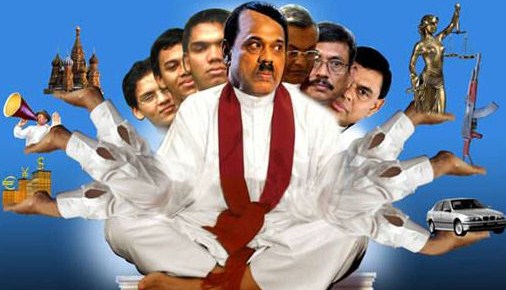A Brief Colonial History Of Ceylon(SriLanka)
Sri Lanka: One Island Two Nations
A Brief Colonial History Of Ceylon(SriLanka)
Sri Lanka: One Island Two Nations
(Full Story)
Search This Blog
Back to 500BC.
==========================
Thiranjala Weerasinghe sj.- One Island Two Nations
?????????????????????????????????????????????????Tuesday, April 17, 2018
A Note On Fear Of Some Sinhala-Buddhists

 “Fear
is a distorting mirror in which anything can appear as a caricature of
itself, stretched to terrible proportions; once inflamed, the
imagination pursues the craziest and most unlikely possibilities. What
is most absurd suddenly seems the most probable.” – Stefan Zweig
“Fear
is a distorting mirror in which anything can appear as a caricature of
itself, stretched to terrible proportions; once inflamed, the
imagination pursues the craziest and most unlikely possibilities. What
is most absurd suddenly seems the most probable.” – Stefan Zweig
Is this what happens in Sri Lanka now?
I recently watched an interview given by one of the prominent and
educated Buddhist monks in a popular Sri Lankan TV, in which he was
expressing his fear about the way the Muslim women wear their attire.
His utterance was against the Supreme Court ruling and therefore a
law-abiding monk will not make such an utterance in public. We all know
the Supreme Court on the 25th July 2014 ordered the Attorney General to
issue directives to all public institutions to permit to wear the
traditional Muslim cultural attire when entering public places. When the
case was taken up for hearing before the Chief Justice Mohan Pieris
said that the traditional Muslim attire was well within the identity of
the Sri Lankan culture and that Muslim women had a right to wear such
attire and it causes harm to none. The Chief Justice also commended the
petitioner’s dress and said that the attire was well within the
boundaries of decency. Accordingly, the Supreme Court bench ordered the
Attorney General to issue instructions to all public institutions not to
obstruct people who wear traditional Muslim attire.
In spite of the above court ruling and provisions in the constitution
(section 14 (1) (e)), the Muslim women face great criticisms in wearing
their cultural attire. On some occasions, they have been subjected to
violence as a result. It is very difficult to understand how the Muslim
women’s attire affects the daily lives of the other communities? Does it
cause any harm to them? Why don’t they accept modesty? Why do they
oppose the decency? Isn’t it a politically motivated criticism of the
entire Sri Lankan Muslim community to achieve petty political objectives
locally and internationally? Why are the educated and decent Sinhala
Buddhists and monks silent on this? What is the response of Maha Sangha
on this? Does their silence on this give approval for these nasty
criticisms?
The above-mentioned monk’s fear was that the government of Saudi Arabia
was funding to wear them the way they wear now to ‘Islamise’ Sri Lanka.
This is absolute nonsense to misguide the Sinhala Buddhists, I believe.
The communal tension we see in Sri Lanka is mainly due to ignorance. We,
every Sri Lankan citizen, can play an important role to remove the
misconceptions.
It is true that there is a certain degree of influence on the Middle
Eastern culture on this cultural transformation of Muslim women’s attire
after the economy was opened in 1977 for foreign employment by J. R.
Jayewardene’s government. Up to the early 1970s, there were a very few
Muslim women who wore Veil and Hijab. This cultural transformation could
also be seen in the lifestyles of Sinhala-Buddhists who
worked in the Middle Eastern countries in their food, eating habits and
hobbies for examples. Even you can see a number of Sinhala Buddhists
shop in the supermarkets that sell exclusively Arabian groceries in SL.
But there is no evidence to suggest that the attire of Muslim women is
funded and influenced by foreign governments. If this is funded by the
Middle Eastern governments, why were those governments numb when the
non-Muslims killed the Muslims and destroyed their properties including
the mosques in Sri Lanka?
Before Veil and Hijab came as part of their daily attire, the Muslim
women used to cover their head with ‘Mukkadu’ (used part of the ‘saree’
to cover their head). They very rarely had a separate piece of cloth to
cover their head. Today, most of the Muslim women use Veil, Hijab or
‘Mukkadu’ as part of their cultural attire. This is partly their
cultural identity too.
Cultural transformation due to foreign link is nothing new to Sri Lankan
women’s attire. Today most of the Sri Lankan Sinhala women wear
‘gauma’. This is not Sinhalese. It is Portuguese. The Sinhalese started
to wear Portuguese dresses from the early part of 16th century when
Portuguese ruled (1505 – 1658) the country. If they oppose foreign
dresses, they should wear sarees (the osariya) or redda-haetta (cloth
and jacket) only. The Sinhala men should not wear trousers and shirt if
they are true Sinhalese. They should wear a sarong or an amude (span
cloth), the Sinhalese wear. Therefore, the foreign cultural influence in
the way the Sri Lankan wear is unavoidable when they interact with
foreigners. That is what happens to the Muslim women and their attire!


